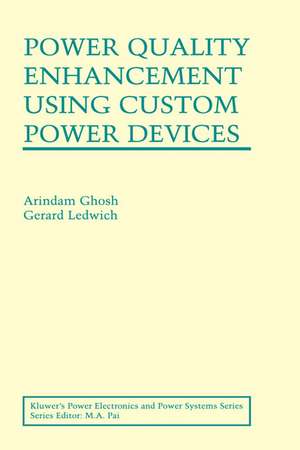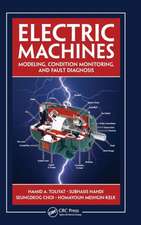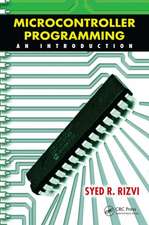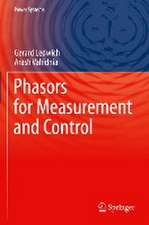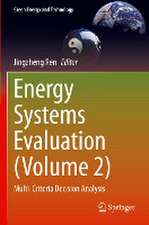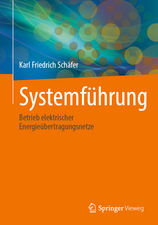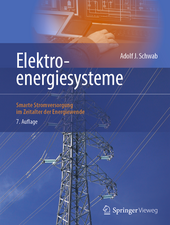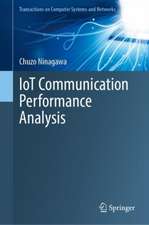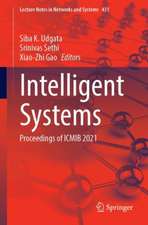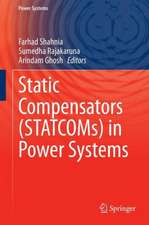Power Quality Enhancement Using Custom Power Devices: Power Electronics and Power Systems
Autor Arindam Ghosh, Gerard Ledwichen Limba Engleză Hardback – 31 aug 2002
Also addressed are other power electronic devices for improving power quality in Solid State Transfer Switches and Fault Current Limiters. Applications for these technologies as they relate to compensating busses supplied by a weak line and for distributed generation connections in rural networks, are included. In depth treatment of inverters to achieve voltage support, voltage balancing, harmonic suppression and transient suppression in realistic network environments are also covered. New material on the potential for shunt and series compensation which emphasizes the importance of control design has been introduced.
| Toate formatele și edițiile | Preț | Express |
|---|---|---|
| Paperback (1) | 1116.71 lei 6-8 săpt. | |
| Springer Us – 30 oct 2012 | 1116.71 lei 6-8 săpt. | |
| Hardback (1) | 1120.99 lei 6-8 săpt. | |
| Springer Us – 31 aug 2002 | 1120.99 lei 6-8 săpt. |
Din seria Power Electronics and Power Systems
- 18%
 Preț: 944.19 lei
Preț: 944.19 lei -
 Preț: 487.37 lei
Preț: 487.37 lei - 20%
 Preț: 630.01 lei
Preț: 630.01 lei - 15%
 Preț: 648.56 lei
Preț: 648.56 lei - 15%
 Preț: 643.84 lei
Preț: 643.84 lei - 18%
 Preț: 1113.89 lei
Preț: 1113.89 lei - 18%
 Preț: 950.33 lei
Preț: 950.33 lei - 18%
 Preț: 1981.53 lei
Preț: 1981.53 lei - 15%
 Preț: 638.43 lei
Preț: 638.43 lei - 18%
 Preț: 1660.95 lei
Preț: 1660.95 lei - 18%
 Preț: 940.87 lei
Preț: 940.87 lei - 15%
 Preț: 637.46 lei
Preț: 637.46 lei - 18%
 Preț: 949.55 lei
Preț: 949.55 lei - 18%
 Preț: 953.65 lei
Preț: 953.65 lei - 18%
 Preț: 953.97 lei
Preț: 953.97 lei - 18%
 Preț: 944.67 lei
Preț: 944.67 lei - 15%
 Preț: 634.32 lei
Preț: 634.32 lei - 18%
 Preț: 832.78 lei
Preț: 832.78 lei - 18%
 Preț: 945.30 lei
Preț: 945.30 lei - 18%
 Preț: 1239.85 lei
Preț: 1239.85 lei - 15%
 Preț: 642.18 lei
Preț: 642.18 lei - 18%
 Preț: 1656.08 lei
Preț: 1656.08 lei - 18%
 Preț: 953.65 lei
Preț: 953.65 lei - 18%
 Preț: 1554.09 lei
Preț: 1554.09 lei - 18%
 Preț: 1657.03 lei
Preț: 1657.03 lei - 18%
 Preț: 951.47 lei
Preț: 951.47 lei - 18%
 Preț: 888.31 lei
Preț: 888.31 lei - 18%
 Preț: 1219.01 lei
Preț: 1219.01 lei - 18%
 Preț: 893.53 lei
Preț: 893.53 lei - 18%
 Preț: 942.94 lei
Preț: 942.94 lei - 18%
 Preț: 1110.24 lei
Preț: 1110.24 lei - 15%
 Preț: 641.85 lei
Preț: 641.85 lei
Preț: 1120.99 lei
Preț vechi: 1367.06 lei
-18% Nou
Puncte Express: 1681
Preț estimativ în valută:
214.53€ • 232.94$ • 180.20£
214.53€ • 232.94$ • 180.20£
Carte tipărită la comandă
Livrare economică 22 aprilie-06 mai
Preluare comenzi: 021 569.72.76
Specificații
ISBN-13: 9781402071805
ISBN-10: 1402071809
Pagini: 484
Ilustrații: XX, 460 p.
Dimensiuni: 155 x 235 x 31 mm
Greutate: 0.79 kg
Ediția:2002
Editura: Springer Us
Colecția Springer
Seria Power Electronics and Power Systems
Locul publicării:New York, NY, United States
ISBN-10: 1402071809
Pagini: 484
Ilustrații: XX, 460 p.
Dimensiuni: 155 x 235 x 31 mm
Greutate: 0.79 kg
Ediția:2002
Editura: Springer Us
Colecția Springer
Seria Power Electronics and Power Systems
Locul publicării:New York, NY, United States
Public țintă
ResearchCuprins
Content.- 1 Introduction.- 1.1 Electric Power Quality.- 1.2 Power Electronic Applications in Power Transmission Systems.- 1.3 Power Electronic Applications in Power Distribution Systems.- 1.4 Distributed Generation.- 1.5 References.- 2 Characterization of Electric Power Quality.- 2.1 Power Quality Terms and Definitions.- 2.2 Power Quality Problems.- 2.3 Conclusions.- 2.4 References.- 3 Analysis and Conventional Mitigation Methods.- 3.1 Analysis of Power Outages.- 3.2 Analysis of Unbalance.- 3.3 Analysis of Distortion.- 3.5 Analysis of Voltage Flicker.- 3.6 Reduced Duration and Customer Impact of Outages.- 3.7 Classical Load Balancing Problem.- 3.8 Harmonic Reduction.- 3.9 Voltage Sag or Dip Reduction.- 3.10 Conclusions.- 3.11 References.- 4 Custom Power Devices: An Introduction.- 4.1 Utility-Customer Interface.- 4.2 Introduction to Custom Power Devices.- 4.3 Custom Power Park.- 4.4 Status of Application of Cp Devices.- 4.5 Conclusions.- 4.6 References.- 5 Structure and Control of Power Converters.- 5.1 Inverter Topology.- 5.2 Hard-Switched Versus Soft-Switched.- 5.3 High Voltage Inverters.- 5.4 Combining Inverters for Increased Power and Voltage.- 5.5 Open-Loop Voltage Control.- 5.6 Closed-Loop Switching Control.- 5.7 Second and Higher Order Systems.- 5.8 Conclusions.- 5.9 References.- 6 Solid State Limiting, Breaking and Transferring Devices.- 6.1 Solid State Current Limiter.- 6.2 Solid State Breaker (SSB).- 6.3 Issues in Limiting and Switching Operations.- 6.4 Solid State Transfer Switch (SSTS).- 6.5 Sag/Swell Detection Algorithms.- 6.6 Conclusions.- 6.7 References.- 7 Load Compensation using DSTATCOM.- 7.1 Compensating Single-Phase Loads.- 7.2 Ideal Three-Phase Shunt Compensator Structure.- 7.3 Generating Reference Currents Using Instantaneous PQ Theory.- 7.4 Generating Reference Currents Using Instantaneous Symmetrical Components.- 7.5 General Algorithm for Generating Reference Currents.- 7.6 Generating Reference Currents When the Source Is Unbalanced.- 7.7 Conclusions.- 7.8 References.- 8 Realization and Control of DSTATCOM.- 8.1 DSTATCOM Structure.- 8.2 Control of DSTATCOM Connected To a Stiff Source.- 8.3 DSTATCOM Connected To Weak Supply Point.- 8.4 DSTATCOM Current Control through Phasors.- 8.5 DSTATCOM in Voltage Control Mode.- 8.6 Conclusions.- 8.7 References.- 9 Series Compensation of Power Distribution System.- 9.1 Rectifier Supported DVR.- 9.2 Dc Capacitor Supported DVR.- 9.3 DVR Structure.- 9.4 Voltage Restoration.- 9.5 Series Active Filter.- 9.6 Conclusions.- 9.7 References.- 10 Unified Power Quality Conditioner.- 10.1 UPQC Configurations.- 10.2 Right-Shunt UPQC Characteristics.- 10.3 Left-Shunt UPQC Characteristics.- 10.4 Structure and Control of Right-Shunt Upqc.- 10.5 Structure and Control of Left-Shunt UPQC.- 10.6 Conclusions.- 10.7 References.- 11 Distributed Generation and Grid Interconnection.- 11.1 Distributed Generation — Connection Requirements and Impacts on the Network.- 11.2 Interaction and Optimal Location of DG.- 11.3 Power Quality in DG.- 11.4 Islanding Issues.- 11.5 Distribution Line Compensation.- 11.6 Real Generation.- 11.7 Protection Issues for Distributed Generation.- 11.8 Technologies for Distributed Generation.- 11.9 Power Quality Impact from Different DG Types.- 11.10 Conclusions.- 11.11 References.- 12 Future Directions and Opportunities for Power Quality Enhancement.- 12.1 Power Quality Sensitivity.- 12.2 Utility Based Versus Customer Based Correction.- 12.3 Power Quality Contribution to the Network from Customer Owned Equipment.- 12.4 Interconnection Standards.- 12.5 Power QualityPerformance Requirements and Validation.- 12.6 Shape of Energy Delivery.- 12.7 Role of Compensators in Future Energy Delivery.- 12.8 Conclusions.- 12.9 References.
